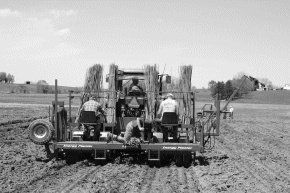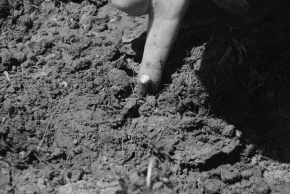Green Horizons
Volume 15, Number 3Summer 2011
Michelle Hall, Marketing and Communications Coordinator, CAFNR Communications
Planting 18,000 cuttings? It's all in a day's - no, make that a couple of hour's - work for the Egedal Energy Planter. The machine is made in Denmark specifically for planting hardwood cuttings. Five-foot-long willow 'whips' are hand-fed through a series of blades, which slice the cuttings into 8-inch pieces and insert them into the ground. The planter is designed to plant the cuttings in a double-row configuration, 2 x 2 feet, and 5 feet between the double rows.
The planter and whips were brought in from Double A Willow of Fredonia, N.Y., which specializes in planting willow. Ken Blitz, operations manager, said they have planted willow with the fast-working machine in Ohio, Michigan, Wisconsin, Pennsylvania, New York and now Missouri. Most of their customers have been researchers, as well as consortiums with power plants - "anyone looking at biomass" he said. "Folks are playing with it all over." Planting willow for bioenergy is Double A's "niche," Blitz said. "We have the machine and now we travel the country."
In addition to the 18,000 willow, there are 18,000 cottonwood and 16,000 silver maple planted on the tract to study as a dedicated bioenergy plantation. John Dwyer, MU associate professor of forestry, is the primary investigator for the project.
The willow will grow through the summer and then be cut back at first frost to encourage multiple sprouts; a process called 'coppicing.' The trees then will be allowed to grow for three more summers before they are harvested.
The final product of the shrub-like trees are wood chips, which will go to the new MU biomass boiler on campus (more on this project in an upcoming issue of GH).
The two varieties of willow are the researchers' guess for what will grow best in Missouri, based on varieties spun off by The State University of New York (SUNY) for biofuel purposes. SUNY's research shows three years' growth leads to optimum yield.
Dwyer and colleagues are looking to secure additional funds for two more blocks of plantings. They will plant further blocks based on the cottonwood varieties that look best after one year, he said.
This study is funded by a Mizzou Advantage grant.
 |  | |
| Above: Crew from Double A Willow of Fredonia, NY and the Egedal Energy Planter. Operations manager, Ken Blitz is holding a bundle of 5-foot-long willow whips. | Above: The Edegal machine plants the cuttings in double-rows, 2 x 2 feet, and 5 feet between the double rows. | |
 |  | |
| Above: A willow cutting is typically 8 inches long | Above: Cuttings are planted deep, so that less than one inch remains above ground. |